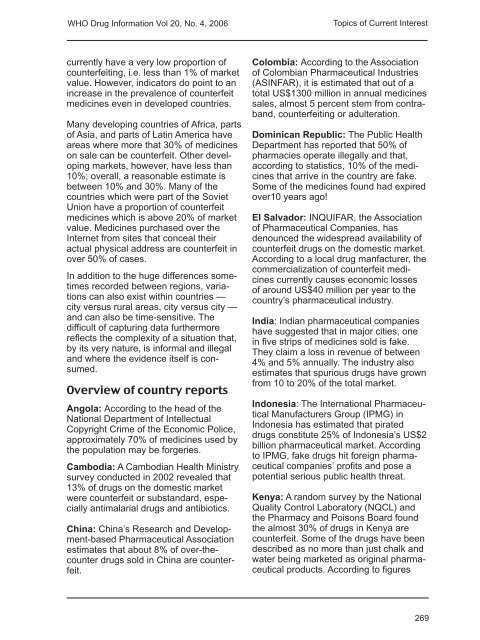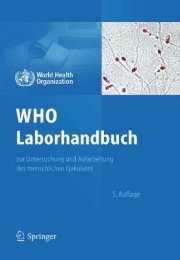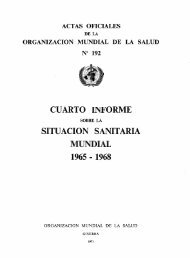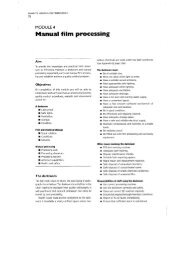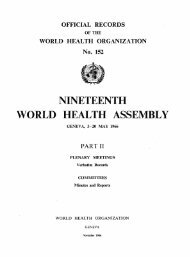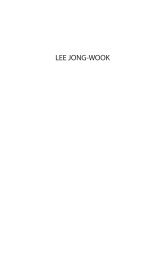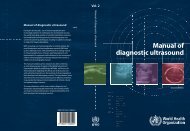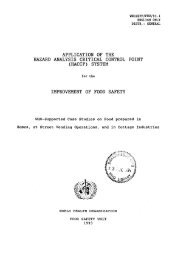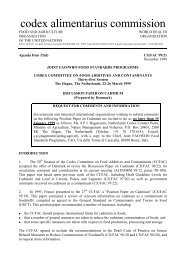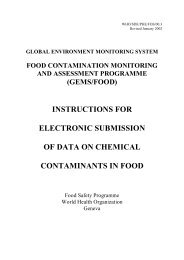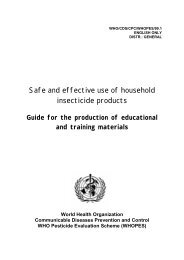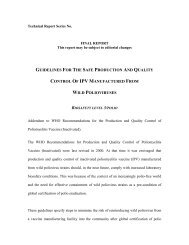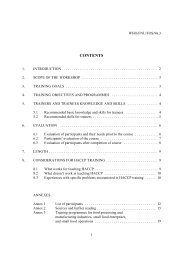WHO Drug Information Vol. 20, No. 4, 2006 - World Health ...
WHO Drug Information Vol. 20, No. 4, 2006 - World Health ...
WHO Drug Information Vol. 20, No. 4, 2006 - World Health ...
Create successful ePaper yourself
Turn your PDF publications into a flip-book with our unique Google optimized e-Paper software.
<strong>WHO</strong> <strong>Drug</strong> <strong>Information</strong> <strong>Vol</strong> <strong>20</strong>, <strong>No</strong>. 4, <strong>20</strong>06 Topics of Current Interest<br />
currently have a very low proportion of<br />
counterfeiting, i.e. less than 1% of market<br />
value. However, indicators do point to an<br />
increase in the prevalence of counterfeit<br />
medicines even in developed countries.<br />
Many developing countries of Africa, parts<br />
of Asia, and parts of Latin America have<br />
areas where more that 30% of medicines<br />
on sale can be counterfeit. Other developing<br />
markets, however, have less than<br />
10%; overall, a reasonable estimate is<br />
between 10% and 30%. Many of the<br />
countries which were part of the Soviet<br />
Union have a proportion of counterfeit<br />
medicines which is above <strong>20</strong>% of market<br />
value. Medicines purchased over the<br />
Internet from sites that conceal their<br />
actual physical address are counterfeit in<br />
over 50% of cases.<br />
In addition to the huge differences sometimes<br />
recorded between regions, variations<br />
can also exist within countries —<br />
city versus rural areas, city versus city —<br />
and can also be time-sensitive. The<br />
difficult of capturing data furthermore<br />
reflects the complexity of a situation that,<br />
by its very nature, is informal and illegal<br />
and where the evidence itself is consumed.<br />
Overview of country reports<br />
Angola: According to the head of the<br />
National Department of Intellectual<br />
Copyright Crime of the Economic Police,<br />
approximately 70% of medicines used by<br />
the population may be forgeries.<br />
Cambodia: A Cambodian <strong>Health</strong> Ministry<br />
survey conducted in <strong>20</strong>02 revealed that<br />
13% of drugs on the domestic market<br />
were counterfeit or substandard, especially<br />
antimalarial drugs and antibiotics.<br />
China: China’s Research and Development-based<br />
Pharmaceutical Association<br />
estimates that about 8% of over-thecounter<br />
drugs sold in China are counterfeit.<br />
Colombia: According to the Association<br />
of Colombian Pharmaceutical Industries<br />
(ASINFAR), it is estimated that out of a<br />
total US$1300 million in annual medicines<br />
sales, almost 5 percent stem from contraband,<br />
counterfeiting or adulteration.<br />
Dominican Republic: The Public <strong>Health</strong><br />
Department has reported that 50% of<br />
pharmacies operate illegally and that,<br />
according to statistics, 10% of the medicines<br />
that arrive in the country are fake.<br />
Some of the medicines found had expired<br />
over10 years ago!<br />
El Salvador: INQUIFAR, the Association<br />
of Pharmaceutical Companies, has<br />
denounced the widespread availability of<br />
counterfeit drugs on the domestic market.<br />
According to a local drug manfacturer, the<br />
commercialization of counterfeit medicines<br />
currently causes economic losses<br />
of around US$40 million per year to the<br />
country’s pharmaceutical industry.<br />
India: Indian pharmaceutical companies<br />
have suggested that in major cities, one<br />
in five strips of medicines sold is fake.<br />
They claim a loss in revenue of between<br />
4% and 5% annually. The industry also<br />
estimates that spurious drugs have grown<br />
from 10 to <strong>20</strong>% of the total market.<br />
Indonesia: The International Pharmaceutical<br />
Manufacturers Group (IPMG) in<br />
Indonesia has estimated that pirated<br />
drugs constitute 25% of Indonesia’s US$2<br />
billion pharmaceutical market. According<br />
to IPMG, fake drugs hit foreign pharmaceutical<br />
companies’ profits and pose a<br />
potential serious public health threat.<br />
Kenya: A random survey by the National<br />
Quality Control Laboratory (NQCL) and<br />
the Pharmacy and Poisons Board found<br />
the almost 30% of drugs in Kenya are<br />
counterfeit. Some of the drugs have been<br />
described as no more than just chalk and<br />
water being marketed as original pharmaceutical<br />
products. According to figures<br />
269


